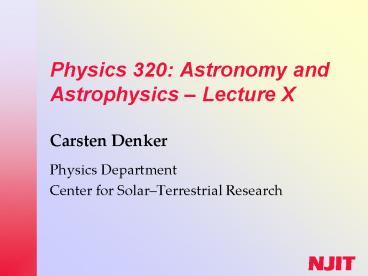Physics 320: Astronomy and Astrophysics Lecture X PowerPoint PPT Presentation
1 / 51
Title: Physics 320: Astronomy and Astrophysics Lecture X
1
Physics 320 Astronomy and Astrophysics Lecture
X
- Carsten Denker
- Physics Department
- Center for SolarTerrestrial Research
2
Problem 9.9
3
Problem 9.12
At wavelength where the opacity is greatest, the
value of s is smallest. If the temperature of the
stars atmosphere increases outward, than a
smaller value of s corresponds to looking at a
higher temperature and a brighter gas. At
wavelength where the opacity is greatest, you
would therefore emission lines.
4
Problem 9.13
A large hollow spherical shell of hot gas will
look like a ring if you can see straight through
the middle of the shell. That is, the shell must
be optically thin, and an optically thin hot gas
produces emission lines. Near the edges of the
shell, where your line of sight passes through
more gas, the shell appears brighter and you see
in a ring.
In 1992 a tremendous explosion occurred in the
constellation of Cygnus. Dubbed Nova Cygni 1992.
Astronomers hypothesize that this system's white
dwarf had so much gas dumped onto it's surface
that conditions became ripe for nuclear fusion.
The resulting thermonuclear detonation blasted
much of the surrounding gas into an expanding
shell.
5
Exhibition Title Contest
- Ian
- Journey to the Center of our/your Universe
- Voyage to the Center of our Solar System
- The Sun More than a Reason to Skip Class
- Our Sun What can it do for you?
- Brick City Sun
- The Key to Live on Earth The Sun
- Our Sun The Orb of Life
- The Giant Nuclear Reactor The Sun
- John
- The Sun Our Closest Star
- The Sun A Look inside our Closest Star
- Gerardo, Matthew, Mike
- Sunbelievable Solar Sciene
6
The Sun
- The Solar Interior
- Mass
- Luminosity
- Radius
- Effective Temperature
- Surface Composition
- The Solar Atmosphere
- The Solar Cycle
7
Sun Overview
8
Evolution of the Sun and its Interior
Standard Solar Model X 0.71 ? 0.34 Y 0.27 ?
0.64
SunEarth Connection?
9
ppChain
Solar Neutrino Problem!
10
Interior Structure
11
Convection Condition
The Sun is purely radiative below r/R? 0.71 and
becomes convective above that point. Physically
this occurs because the opacity in the outer
layers of the Sun becomes large enough to inhibit
the transport of energy.
12
Differential Rotation and Magnetic Fields
13
Helioseismology
14
Photosphere
15
Sunspots Umbra and Penumbra
16
Active Regions
Active region 9169 was the host of the largest
sunspot group observed so far during the current
solar cycle. On 20 September 2000, the sunspot
area within the group spanned 2,140 millionths of
the visible solar surface, an area a dozen times
larger than the entire surface of the Earth!
17
Spectrum of Granulation
Wiggly spectral lines in the solar photosphere
inside and outside a region of activity,
reflecting rising and sinking motions in
granulation. Over the central one third of the
spectrogram height, the slit crossed a
magnetically active region. Here, the velocity
amplitudes are much reduced, demonstrating how
convection is disturbed in magnetic areas.
18
Model of Convection
3D animation of convection. The animation shows
temperature fluctuations in a layer of unstable,
turbulent gas. (Courtesy of Andrea Malagoli,
University of Chicago)
19
Supergranulation
20
Photospheric Magnetic Fields
21
Sunspots Pores Filigree
22
Thin Flux Tube Model
23
Magnetic Carpet
24
Chromosphere
25
Mercury Transit November 15th,
1999
The images were taken 20 seconds apart from 2111
(first contact) to 2210 UT (last contact). The
image were captured with a Kodak MegaPlus 4.2 CCD
camera. The spatial resolution is about 1?? per
pixel. Here, we show only a small portion of the
full disk images near the solar north pole. The
field of view is approximately 470?? ? 170?? or
340,000 km ? 125,000 km on the Sun.
26
Prominences
The SoHO EIT full sun image, taken on 14
September 1999 in the He II line at 304 Å shows
the upper chromosphere/lower transition region at
a temperature of about 60,000 K. The bright
features are called active regions. A huge
erupting prominence escaping the Sun can be seen
in the upper right part of the image. Prominences
are cool 60,000 K plasma embedded in the much
hotter surrounding corona, which is typically at
temperatures above 1 million K.
27
Filament Evolution
Temporal evolution in Ha center line of a
sigmoidal filament in active region NOAA 8668
during August 2000.
(a) Videomagnetogram , (b) CaI line wing
filtergram, (c) Ha 0.6 Å filtergram, and (d) Ha
center line filtergram.
28
Filament Eruption
29
Sympathetic Flare
30
Transition Region Corona
31
Corona EIT 304 Å
32
Corona EIT 171 Å
33
Corona LASCO C2
34
Corona LASCO C3
35
Corona and Planets
36
Coronal Mass Ejection LASCO
37
Coronal Mass Ejection Comet
38
Coronal Mass Ejection TRACE
39
Space Weather
40
Space Weather Sun Earth
Connection
41
Space Weather Bow Shock
42
Space Weather Effects on Earth
43
Solar Cycle Butterfly Diagram
44
Solar Cycle
45
Solar Cycle Synoptic Map
46
Big Bear Solar Observatory
47
Telescopes and Control Room
48
BBSO Instruments
49
Optical Lab and Parallel Computer
50
Homework Class Project
- Continue improving the PPT presentation.
- Use the abstract from the previous assignment as
a starting point for a PowerPoint presentation. - The PPT presentation should have between 5 and 10
slides. - Bring a print-out of the draft version to the
next class as a discussion template for group
work - Homework is due Wednesday November 12th, 2003 at
the beginning of the lecture! - Exhibition name competition!
51
Homework
- Homework is due Wednesday November 12th, 2003 at
the beginning of the lecture! - Homework assignment Problems 11.1, 11.2, and
11.8! - Late homework receives only half the credit!
- The homework is group homework!
- Homework should be handed in as a text document!

